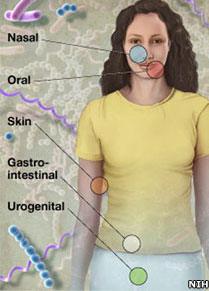Human Microbiome Project reveals largest microbial map
- Published

Researchers sampled five areas of the bodies of healthy volunteers
"When I get up from my chair, ten times more bacterial cells get up than human ones," says Dr Bruce Birren.
He is one of the hundreds of US scientists involved in the world's most extensive map of the microbes that live in and on us.
The <link> <caption>Human Microbiome Project</caption> <url href="http://commonfund.nih.gov/hmp/" platform="highweb"/> </link> has catalogued the genetic identity of many bacteria, viruses and other organisms that live in intimate contact with us.
They are not germs that need eliminating but a fundamental part of what makes us human, researchers say.
Yet until recently, little was known about the identity of trillions of the microbes populating our bodies.
'Beneficial bugs'
For centuries we could only investigate microbes that can survive in laboratories and study them in isolation - often one microbe at a time.
But with the advent of ever-improving techniques to sequence DNA, the Human Microbiome Project has been able to uncover microbes that have never been seen before and look at how they behave as communities.
Many of the results of the five-year project, launched by the National Institutes of Health, have been published in <link> <caption>Nature</caption> <altText>link to journal - Nature </altText> <url href="http://www.nature.com/nature" platform="highweb"/> </link> , <link> <caption>Genome Biology</caption> <url href="http://genomebiology.com/2012/13/6/R42" platform="highweb"/> </link> and <link> <caption>PLoS</caption> <altText>Public Library of Science</altText> <url href="http://www.ploscollections.org/hmp" platform="highweb"/> </link> journals.
Over 200 healthy men and women from the US had microbe samples taken from various parts of their bodies.
And researchers were able to find over 10,000 different types of organisms as part of the healthy human microbiome.
Most of these microbes appeared to do no harm at all. In fact, there is growing evidence that these bugs help us in many ways.
Some help us get energy from food and others help us absorb nutrients such as vitamins.
'Shared microbes?'
And we are learning about the role they play in shaping, rather than just attacking our immune systems, says Prof Barbara Methe of the J Craig Venter Institute, also involved in the project.
One of the key questions researchers asked was - is there a core set of microbes that all humans share?
Scientists actually found a diversity of microbes across different human beings and unique communities of microbes living at different body sites.
But what surprised some is that at specific parts of the body, many of the microbes shared similar jobs.
"I might have a different organism on my tongue than you do on your tongue but collectively they bring the same genes to the party - so they are able to perform some of the same functions, for example, breaking down sugars," Dr Birren says.

Until recently scientists could only identify microbes that could be grown in a laboratory
This finding suggests a shift in thinking from a one-microbe model of disease, that essentially pins the blame for certain illnesses on one bug.
'Bacterial phone-book'
Perhaps what matters in some diseases is not the particular type of bug, but that the function of this group of bugs has somehow gone awry, Dr Huttenhower says.
Researchers found that healthy volunteers carry low levels of microbes, classically thought to cause disease.
For example, the bacteria Staphylococcus aureus, which can be involved the infection MRSA, was found in the noses of about 30 percent.
"We now have a phone-book of 100 of these bugs, which in the right environment, have the potential to go bad.
"We know where they live in healthy people and which organisms surround them too. So perhaps we can begin to understand what keeps them in check and where their reservoirs are," says Dr Curtis Huttenhower from the Harvard School of Public Health.
And together these microbes carry many genes.
These genes have just as much ability to influence our health and disease-risk as our own, says Dr Huttenhower.
In the long-term, the ability to refer to this new genetic database and investigate microbiomes that fall outside its boundaries, will be very important, he says.
'Unknown land'
Dr Lita Proctor, programme director of the project says there is a growing understanding that we pick up our microbiomes in the very early stages of life.
"The human genome is inherited but the human microbiome is acquired- that means it has a very important changeable, mutable property.
"This gives us something to work with in the clinic. If you can manipulate the microbiome you can keep a healthy microbiome healthy or re-balance an unhealthy one," she says.
But who owns the microbiomes inhabiting our bodies? And what does this mean for the regulation of pro-biotics that can change them?, asks ethicist Dr Amy McGuire of Baylor College of Medicine.
These are questions that will need to be ironed out as our knowledge of this area expands, she says.
But we only have half the story. We need to find out much more about how the microbiome talks to human cells says Prof David Relman of Stanford University.
"It is still an unknown land. Even though it is on home turf we are still discovering new life forms on it," he says.
- Published19 October 2011